Straw instead of potting soil - that actually works. We'll tell you what's behind the new trend and how gardening on straw works.

Good soil is important if you want to enjoy lush flowers and healthy vegetables. But that's only partly true: In fact, you can grow plants with simple straw bales on infertile and sealed soil without much effort. No wonder, then, that gardening on straw has blossomed into a real insider tip that is finding more and more followers.
You can find out here what you need to know about the unusual trend of gardening on straw and how you can create a garden on straw yourself. We present both advantages and disadvantages and provide detailed instructions.
contents
- Pros and cons of gardeners on straw
- Gardening on straw: you need it
- Instructions for gardening on straw bales
Pros and cons of gardeners on straw
Gardening on straw has one particular advantage: you are independent of the respective subsoil. Gardeners with balconies, terraces or large, paved courtyards are particularly enthusiastic about the new cultivation trend, because they can grow flowers and vegetables without any plastic tubs or flower pots. But even with very infertile, salty or stony soil on which only a few plants thrive, a straw bale garden can be a real It's a relief - with the straw bale as a base, you can start gardening quickly and easily without having to costly rehabilitate the soil have to.
But straw gardening has other advantages. Straw gardeners like to emphasize the reduced weed pressure in particular. Since the plants grow higher on the straw bales, weeds and soil-borne diseases hardly stand a chance. Even waterlogging can hardly occur, as excess water can simply drain off. bumblebees and wild bees On the other hand, they benefit from the straw because they find a natural shelter here. In addition, vegetables and flowers often grow faster on the straw bale than in the bed. This phenomenon is caused by the heat generated when the straw rots (similar to a raised bed) is released.
Last, of course, are the optics and the sustainability of the raw material straw. Straw beds often have a very rustic and country charm that is popular with many gardeners. At the same time, it is easily compostable and can therefore be recycled without leaving any residue - in contrast to flower pots made of plastic, which only decompose after decades.
But gardening on straw also has disadvantages: the heat released not only allows plants to thrive, but also mushrooms. So-called slime molds can develop, which are not particularly attractive. In addition, gardening on straw has a significantly higher risk than gardening in beds Fertilizer consumption, which can lead to environmental pollution if one does not switch to organic alternatives grabs.

What are the advantages of gardening on straw?
- Gardening also possible on poor soil, flexible use
- Protection against weeds and soil-borne diseases
- Avoiding waterlogging
- Better growth with warmth
- Appealing appearance
- Straw can be composted
- Retreat for bumblebees and wild bees
What are the disadvantages of gardening on straw?
- Stronger growth of fungi
- High fertilizer consumption
Gardening on straw: you need it
If you want to grow your own plants on a straw bale, you can find almost everything you need in the house. The most important are the straw bales, which you can often buy cheaply on farms or in companies with horses in the area. In a vegetable garden, straw from organic farms should be used to avoid exposure to pesticides. Small, rectangular bales are best for gardening, because they can be easily moved by hand and fit into any garden. If you have a larger property, you can also use large square bales - but these are often heavy and awkward to transport. In principle, round bales are also suitable for gardening, but hay is not a good starting material.

As already mentioned, the fertilizer consumption is increased with this type of gardening, which makes it all the more important is to use a bio-fertilizer with long-term organic action in order not to harm the environment burden. We therefore particularly recommend ours Plantura organic fertilizer, which are made from purely plant-based raw materials and pose no risk to the environment.
What do you need for gardening on straw?
- straw bale
- organic fertilizer
- water, a watering can or a hose
- gloves
- shovel
- plant
- Possibly wood or wire for the cladding or Attachment for the straw bales

Instructions for gardening on straw bales
Many people think that when gardening on straw, you can just put the plants in the pads. In fact, the straw bales must first be prepared before you can actually start gardening. Before that, however, you should choose a suitable place for your straw bale garden - since the straw bale If a large amount of water is added during preparation, they are significantly heavier later on and therefore also more difficult to use offset. In addition, you can think about whether you want to build a cladding (e.g. made of boards) for your straw bale or whether you want to additionally fasten the bale with wire. This is useful because the bales lose stability over time as they decompose. Gloves should be worn at all times when handling the bale of straw, as it is easy to injure yourself on the prickly straw.
Now the actual preparation of the straw bale can begin: the bale has to be watered every day for ten days. In addition, fertilizer is added every other day. In this case, it is particularly important to pay attention to a high nitrogen concentration. Our Plantura organic universal fertilizer with organic long-term effect has an NPK ratio of 6-3-4 and is therefore excellently suited for fertilizing straw bales. On the sixth day, a slightly sweet odor should be noticeable on the straw and a slightly higher temperature as a result of the rotting processes. If the smell is fresh again on the tenth day, you can start gardening.
With a plant trowel or a small shovel, holes can now be dug in the bales, in which the plants can later be placed. A small layer of potting soil is also filled into the holes - this helps the plants to get used to the new location without their growth faltering. Then the plants can simply be placed in the straw bale with some soil on the root ball. After that, the plants are regularly supplied with water and fertilizer as in the normal bed until they are ready for harvest. By the way, they are ideal for cultivation on straw paprika (capsicum), Tomatoes (Solanum lycopersicum), various types of cabbage and lettuce (Lactuca sativa) suitable. But also flowers like Nasturtium (tropaeolum) or marigold (Calendula officinalis) feel comfortable in the straw.

How is a straw garden properly laid out?
- Place straw bales in the appropriate place
- Possibly disguise or attach straw bales
- Water every day for ten days
- Fertilize adequately every other day
- After ten days, poke small holes with a garden trowel
- Fill holes with some potting soil
- Place seedlings in the straw bale
If you're still interested in unusual forms of gardening, here's how to do one Mushroom growing on coffee grounds or on tree trunks can create.



